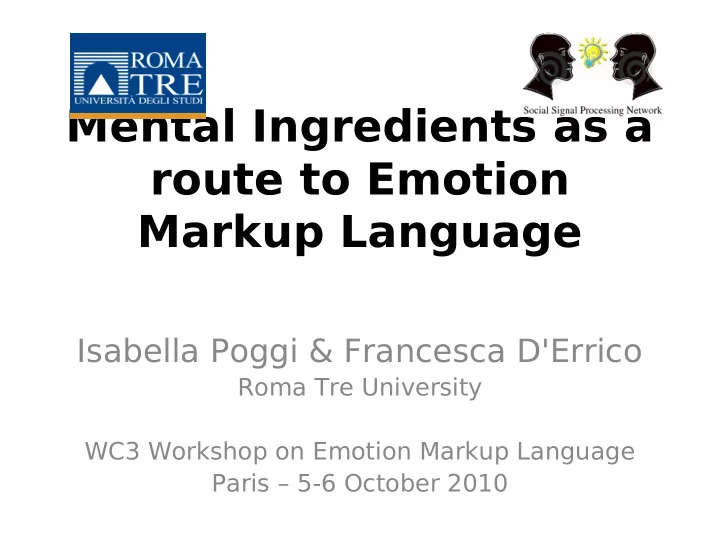

Mental Ingredients as a route to Emotion Markup Language Isabella Poggi & Francesca D'Errico Roma Tre University WC3 Workshop on Emotion Markup Language Paris – 5-6 October 2010
A definition of Emotion According to a model in terms of goals and beliefs (Castelfranchi 1988; 2000; Castelfranchi & Poggi 1990; (Castelfranchi 1988; 2000; Castelfranchi & Poggi 1990; Miceli & Castelfranchi 1995; 2007) Miceli & Castelfranchi 1995; 2007) an EMOTION is a subjective state encompassing cognitive, physiological, expressive, motivational aspects that is triggered when an Agent believes that a current event causes or is likely to cause the achievement or thwarting of an important goal of the Agent
The adaptive function of Emotions Emotions are an adaptive device aimed at monitoring the state of achievement – thwarting of the Agent’s adaptively important goals (Darwin, 1872; Frijda, 1986; Castelfranchi, 1995; 2000; Scherer 2003)
The “mental ingredients” of emotions Beliefs represented in the mind of the Beliefs represented in the mind of the Agent who is feeling the emotion, Agent who is feeling the emotion, concerning concerning 1. the current event and its relationship to the Agents’ goals 2. the goals monitored by the emotion 3. the goals activated by the emotion
Some methods to find out the ingredients • Semantic analysis : analysis of a lexical area in a natural language. Ex. To analyse pride: pride, proud, cocky, haughty, presumptuous, arrogant • Conceptual analysis : the investigator produces examples and counter-examples to discover the necessary and sufficient conditions for feeling an emotion • Empirical investigation : the investigator submits interviews and questionnaires to people
Semantic analysis • Dimensions that differentiate words concerning pride in italian
Conceptual analysis • A lead: dimensions
Dimensions • MONITORED GOAL • Shame , goal of (self)image, Fear , survival and wellbeing • VALENCE goals • + goal achievements, joy • TIME • - goal thwartings, sorrow • DEGREE OF • Joy, sorrow after CERTAINTY • Hope, fear during • joy – enthusiasm –
Dimensions • disappointment implies goal COGNITIVE ELEMENTS thwarting but also previous expectation of success expectations, • Guilt may require self- causal attributions, attribution of cause and evaluations resposibility • Shame, guilt, contempt contain evaluations POWER OF CONTROL • The “potency” dimension: • Ex. Fear vs. Anger ARGUMENTAL STRUCTURE • Emotions “towards” someone else: love, hate, admiration, INTENSITY : contempt • Annoyance, anger, rage, fury
Prototypes applied to the mental ingredients of emotions • Some cases of an emotion contain all the ingredients prototypical cases • Some cases only contain a subset of the ingredients of the emotion • Final goal of the analysis: • to find out the common ingredients that are present in all cases • both prototypical and non-prototypical ones
Different kinds of admiration by adding ingredients Intense The object is a A wants to have A evaluates Pleasant quality B’s quality positively Emotion of A the goals to of a person B A believes A is Due to a which B similar to B A does not have applies positive A believes A can quality X quality X evaluation achieve B’s A evaluates B quality That B has quality X of an object X positively causes A to A wants to Seen as imitate B A wants to have believe that beautiful positive to an extent B is superior to A interactions that is with B surprising Landscape Maria and Yuri Mantaigne and Chechi the statue The follower The detective and and the the gangster leader
Pride • Pride is the emotion signalling the achievement of the goal of image and/or of self-image • Therefore to show pride means that – You have done something good Internal attribution of success – You are a winner – You have more power than others
The two facets of pride Pride is not a single unified construct, but there are two theoretically and empirically distinct facets (Lewis, 2000; Tracy & Robins, 2007 ). Authentic pride , is based on specific achievements “I’m proud of what I did”; Hubristic pride , is based on global positive feelings about the stable self “I’m proud of who I am”
Three types of pride Three types of pride = Three types of power relationships Real Ideal DIGNITY: level level Image of self-sufficiency in order to reach equity (i.e.stigmatized minorities who claim A < B A = B for equity) SUPERIORITY: Image of superiority (based on past or on A ≥ B A > B acknowledged level) in order to gain dominance or to be re-acknowledged ARROGANCE: Image of superiority against someone; A ≤ B A > B provocation oriented to gain dominance or to challenge social hierarchy or social rules;
Communication of pride as strategy for social change • Dignity Pride is a a way to restablish paired relations • Superiority Pride is a way to express dominance and (re)gain power • Arrogance Pride is a way to challenge the establishment
The prototypical expression of pride (Tracy, 2004;2007) • small smile • expanded posture • head-tilt back • arms extended out from the body; with hands on hips. “authentic and hubristic pride share the same signal”
Do the “three facets” of pride - dignity, superiority, arrogance - have the same pattern of expression?
Combination of signals • Different combinations of the same basic signals for the different types of pride?
Recommend
More recommend